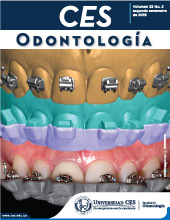Terapia de Tração Extraoral Cervical no Tratamento Precoce da Maloclusão Classe II. Uma revisão sistemática
DOI:
https://doi.org/10.21615/cesodon.32.2.2Palavras-chave:
tração extraoral cervical, má oclusão classe II, tratamento precoceResumo
Introdução e objetivo: A tração cervical tem sido utilizada como tratamento da má oclusão de classe II. Embora os efeitos tenham sido relatados anteriormente, eles são contraditórios. O objetivo foi determinar as evidências científicas disponíveis que suportam os parâmetros de uso clínico para terapia com tração extraoral cervical no tratamento precoce da má oclusão de classe II. Materiais e métodos: Uma pesquisa sistemática foi realizada usando Medline, Google Scholar, Cochrane e Lilacs. Foram incluidos artigos em inglês, espanhol, português e alemão, usando termos MeSH selecionados anteriormente e termos de texto livre. A pesquisa incluiu artigos que tratavam do tratamento da tração extraoral cervical, revisões sistemáticas, meta-análise, ensaios clínicos e estudos de coorte, caso-controle e transversais. A qualidade metodológica foi avaliada usando várias escalas de acordo com o tipo de estudo. Resultados: a busca gerou 334 artigos, 259 foram eliminados por serem duplicados e 34 foram eliminados por não atenderem aos critérios de inclusão. 41 artigos foram avaliados em texto completo, 21 foram excluídos por não atenderem aos critérios de inclusão, totalizando 20 artigos. Conclusões: Os artigos oferecidos apresentaram recomendações variadas, porém claras. De acordo com a literatura e o julgamento clínico, o momento do tratamento é recomendado durante o surto de crescimento puberal. A força mais eficiente é de 450 a 500g por lado, durante 12 a 14 horas por dia. Um arco externo longo e dobrado de 15 graus deve ser usado em pacientes com padrões normais e hipodivergentes. O controle do crescimento maxilar depende da idade, força, duração do tratamento, etc. Alterações no overjet podem ser esperadas devido a alterações na inclinação dentária, crescimento ou uso de aparelhos adicionais; uma distalização molar média de 1 mm a 2 mm pode ser alcançada.
Downloads
Referências
Melsen B, Enemark H. Effect of cervical anchorage studied by the implant method. Rep Congr Eur Orthod Soc. 1969;435–447.
Wieslander L. The effect of force on craniofacial development. Am J Orthod. 1974 May;65(5):531–538.
Baumrind S, Molthen R, West EE, Miller DM. Mandibular plane changes during maxillary retraction. Am J Orthod. 1978;74(1):32–40.
Melsen B. Effects of cervical anchorage during and after treatment: an implant study. Am J Orthod. 197873(5):526–540.
Tulloch JF, Proffit WR, Phillips C. Influences on the outcome of early treatment for Class II malocclusion. Am J Orthod Dentofac Orthop Off Publ Am Assoc Orthod Its Const Soc Am Board Orthod. 1997111(5):533–542.
Tulloch JF, Phillips C, Proffit WR. Benefit of early Class II treatment: progress report of a two-phase randomized clinical trial. Am J Orthod Dentofac Orthop Off Publ Am Assoc Orthod Its Const Soc Am Board Orthod. 1998;113(1):62–72, quiz
–74.
Kirjavainen M, Kirjavainen T, Hurmerinta K, Haavikko K. Orthopedic cervical headgear with an expanded inner bow in class II correction. Angle Orthod. 2000;70(4):317–325.
Henriques FP, Janson G, Henriques JFC, Pupulim DC. Effects of cervical headgear appliance: a systematic review. Dent Press J Orthod. 2015;20(4):76–81.
Pirttiniemi P, Kantomaa T, Mäntysaari R, Pykäläinen A, Krusinskiene V, Laitala T, et al. The effects of early headgear treatment on dental arches and craniofacial morphology: an 8 year report of a randomized study. Eur J Orthod. 2005;27(5):429–436.
Papageorgiou SN, Kutschera E, Memmert S, Gölz L, Jäger A, Bourauel C, et al. Effectiveness of early orthopaedic treatment with headgear: a systematic review and meta-analysis. Eur J Orthod. 2017;39(2):176–187.
Baumrind S, Korn EL, Isaacson RJ, West EE, Molthen R. Quantitative analysis of the orthodontic and orthopedic effects of maxillary traction. Am J Orthod. 1983;84(5):384–398.
Hubbard GW, Nanda RS, Currier GF. A cephalometric evaluation of nonextraction cervical headgear treatment in Class II malocclusions. Angle Orthod. 1994;64(5):359–370.
Keeling SD, Wheeler TT, King GJ, Garvan CW, Cohen DA, Cabassa S, et al. Anteroposterior skeletal and dental changes after early Class II treatment with bionators and headgear. Am J Orthod Dentofac Orthop Off Publ Am Assoc Orthod Its Const Soc Am Board Orthod. 1998;113(1):40–50.
Ulger G, Arun T, Sayinsu K, Isik F. The role of cervical headgear and lower utility arch in the control of the vertical dimension. Am J Orthod Dentofac Orthop Off Publ Am Assoc Orthod Its Const Soc Am Board Orthod. 2006;130(4):492–501.
Higgins J, Green S. .Manual Cochrane de revisiones sistemáticas de intervenciones. versión 5.1.0. Oxford; 2011.
Jadad AR, Moore RA, Carroll D, Jenkinson C, Reynolds DJ, Gavaghan DJ, et al. Assessing the quality of reports of randomized clinical trials: is blinding necessary? Control Clin Trials. 1996;17(1):1–12.
Shea BJ, Bouter LM, Peterson J, Boers M, Andersson N, Ortiz Z, et al. External validation of a measurement tool to assess systematic reviews (AMSTAR). PLoS ONE. 2007;2(12):e1350.
Berra S, Elorza-Ricart JM, Estrada M-D, Sánchez E. [A tool (corrected) for the critical appraisal of epidemiological cross-sectional studies]. Gac Sanit SESPAS. 2008 ;22(5):492–497.
Alió-Sanz J, Iglesias-Conde C, Lorenzo-Pernía J, Iglesias-Linares A, Mendoza-Mendoza A, Solano-Reina E. Effects on the maxilla and cranial base caused by cervical headgear: a longitudinal study. Med Oral Patol Oral Cirugía Bucal. 2012;17(5):e845–851.
Bondemark L, Karlsson I. Extraoral vs intraoral appliance for distal movement of maxillary first molars: a randomized controlled trial. Angle Orthod. 2005;75(5):699–706.
Godt A, Kalwitzki M, Göz G. Retrospective analysis of casts to assess cervical headgear treatment in the presence of vertical growth pattern. J Orofac Orthop Fortschritte Kieferorthopädie OrganOfficial J Dtsch Ges Für Kieferorthopädie. 2005;66(3):230–240.
Godt A, Kalwitzki M, Göz G. Effects of cervical headgear on overbite against the background of existing growth patterns. A retrospective analysis of study casts. Angle Orthod. 2007;77(1):42–46.
Godt A, Berneburg M, Kalwitzki M, Göz G. Cephalometric analysis of molar and anterior tooth movement during cervical headgear treatment in relation to growth patterns. J Orofac Orthop Fortschritte Kieferorthopädie OrganOfficial J Dtsch Ges Für Kieferorthopädie. 2008;69(3):189–200.
Kirjavainen M, Kirjavainen T, Haavikko K. Changes in dental arch dimensions by use of an orthopedic cervical headgear in Class II correction. Am J Orthod Dentofac Orthop Off Publ Am Assoc Orthod Its Const Soc Am Board Orthod. 1997;111(1):59–66.
Kirjavainen M, Kirjavainen T. Maxillary expansion in Class II correction with orthopedic cervical headgear. A posteroanterior cephalometric study. Angle Orthod. 2003;73(3):281–285.
Kirjavainen M, Hurmerinta K, Kirjavainen T. Facial profile changes in early Class II correction with cervical headgear. Angle Orthod. 2007;77(6):960–967.
Kopecky GR, Fishman LS. Timing of cervical headgear treatment based on skeletal maturation. Am J Orthod Dentofac Orthop Off Publ Am Assoc Orthod Its Const Soc Am Board Orthod. 1993;104(2):162–169.
Lima Filho RMA, Lima AL, de Oliveira Ruellas AC. Mandibular changes in skeletal class II patients treated with Kloehn cervical headgear. Am J Orthod Dentofac Orthop Off Publ Am Assoc Orthod Its Const Soc Am Board Orthod. 2003;124(1):83–90.
Lima Filho RMA, Lima AL, de Oliveira Ruellas AC. Longitudinal study of anteroposterior and vertical maxillary changes in skeletal class II patients treated with Kloehn cervical headgear. Angle Orthod. 2003;73(2):187–193.
Lione R, Franchi L, Laganà G, Cozza P. Effects of cervical headgear and pendulum appliance on vertical dimension in growing subjects: a retrospective controlled clinical trial. Eur J Orthod. 2015;37(3):338–344.
Mäntysaari R, Kantomaa T, Pirttiniemi P, Pykäläinen A. The effects of early headgear treatment on dental arches and craniofacial morphology: a report of a 2 year randomized study. Eur J Orthod. 2004;26(1):59–64.
Melsen B, Dalstra M. Distal molar movement with Kloehn headgear: is it stable? Am J Orthod Dentofac Orthop Off Publ Am Assoc Orthod Its Const Soc Am Board Orthod. 2003;123(4):374–378.
Varlik SK, Iscan HN. The effects of cervical headgear with an expanded inner bow in the permanent dentition. Eur J Orthod. 2008;30(4):425–430.
Kloehn SJ. Evaluation Of Cervical Anchorage Force In Treatment. Angle Orthod. 1961;31(2):91–104.
King EW. Cervical Anchorage in Class II, Division I Treatment, A Cephalometric Appraisal. Angle Orthod. 1957;27(2):98–104.
Tulloch JF, Phillips C, Koch G, Proffit WR. The effect of early intervention on skeletal pattern in Class II malocclusion: a randomized clinical trial. Am J Orthod Dentofac Orthop Off Publ Am Assoc Orthod Its Const Soc Am Board Orthod.
;111(4):391–400.
Hunter CJ. The correlation of facial growth with body height and skeletal maturation at adolescence. Angle Orthod. 1966;36(1):44–54.
Yepes E, Quintero P, Rueda ZV, Pedroza A. Optimal force for maxillary protraction facemask therapy in the early treatment of class III malocclusion. Eur J Orthod. 2014;36(5):586–594.
Cook AH, Sellke TA, BeGole EA. Control of the vertical dimension in Class II correction using a cervical headgear and lower utility arch in growing patients. Part I. Am J Orthod Dentofac Orthop Off Publ Am Assoc Orthod Its Const Soc Am
Board Orthod. 1994;106(4):376–388.
Brown P. A cephalometric evaluation of high-pull molar headgear and face-bow neck strap therapy. Am J Orthod. 1978;74(6):621–632.
Boecler PR, Riolo ML, Keeling SD, TenHave TR. Skeletal changes associated with extraoral appliance therapy: an evaluation of 200 consecutively treated cases. Angle Orthod. 1989;59(4):263–270.
Boatwright P. Single arch treatment with the Kloehn headgear: A cephalometric evaluation. [unpublished Master’s Thesis]. Department of Orthodontics, St. Louis University;; 1968.
Cangialosi TJ, Meistrell ME, Leung MA, Ko JY. A cephalometric appraisal of edgewise Class II nonextraction treatment with extraoral force. Am J Orthod Dentofac Orthop Off Publ Am Assoc Orthod Its Const Soc Am Board Orthod. 1988;93(4):315–324.
Ghafari J, Shofer FS, Jacobsson-Hunt U, Markowitz DL, Laster LL. Headgear versus function regulator in the early treatment of Class II, division 1 malocclusion: a randomized clinical trial. Am J Orthod Dentofac Orthop Off Publ Am Assoc
Orthod Its Const Soc Am Board Orthod. 1998;113(1):51–61.
Downloads
Publicado
Como Citar
Edição
Seção
Licença
Copyright (c) 2019 CES Odontología

Este trabalho está licenciado sob uma licença Creative Commons Attribution-NonCommercial-ShareAlike 4.0 International License.
| Métricas do artigo | |
|---|---|
| Vistas abstratas | |
| Visualizações da cozinha | |
| Visualizações de PDF | |
| Visualizações em HTML | |
| Outras visualizações | |



